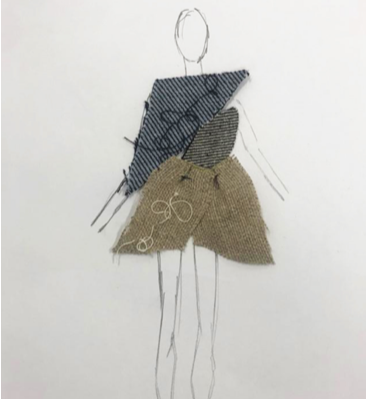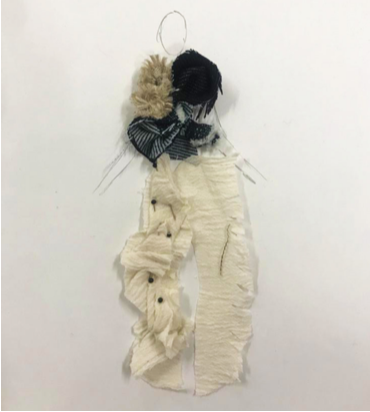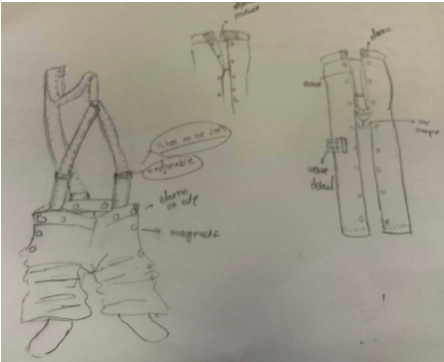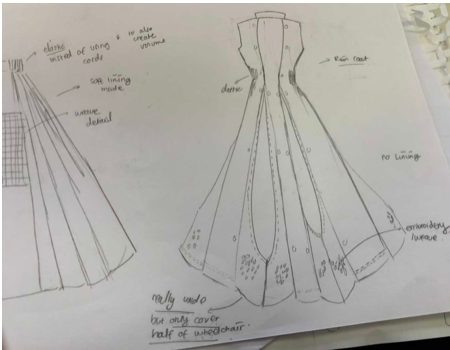Adapt to Adaptive Clothing
- lexisjackson
- Feb 25, 2021
- 8 min read
Companies and designers that are empowering disability in the fashion world.
Shouldn’t everyone be able to access the runway of their dreams? Since the conversation is changing, and we are adapting to new normals worldwide, the time is now to speak up! One topic that is coming to the forefront is adaptive clothing in the fashion market. With Covid-19 propelling fashion to look at its moral compass, we are looking at brands and designers who are on the mission to make clothing not only accessible but fashion-forward to all.
When looking at the world of adaptable clothing, there is a lot to consider, and the process takes a lot of understanding who the customer is. So what is adaptive clothing? Adaptive clothing refers to clothing for those who have medical, physical, and/or mental conditions. These conditions make it challenging to do certain things daily. Still, clothing should not be one of them, whether it is dressing from a wheelchair, having sensory-friendly fabric, genderless shapes, or merely breathable material. Gone are the times of old, outdated accessibility garments, and in are the times of clothing that fits the needs of many.
Disability makes up a large part of the population that should not be left ignored or passed over. According to statista.com, by 2024, The market will grow from 300 billion to 348.81 billion USD. This increase is a 69.9 billion increase from 2019. We can see that the market is expanding, and more innovators want to make the world a more inclusive place.
In 2018 we saw a big break out in the world of accessible clothing when the brand Tommy Hilfiger partnered with Runway of Dreams foundation to launch their first adaptive clothing brand and bringing these options to the mainstream audience. The campaign showcased adaptive clothing, including prominent figures in the disability community such as, Jeremy Campbell, a Paralympic track-and-field gold medalist, and Chelsie Hill, a dancer who uses a wheelchair. Tommy Hilfiger's collection is inspired by his own family life and understanding his children with disabilities to 'uncover solutions that work.' Although not the first to debut accessible clothing, this collection was a big step in the accessibility world. It showed a well-established brand standing behind this transition along with promoting The Runway of Dreams Foundation whose goal is to support programs that highlight the needs for mainstream adaptive apparel and showcase people with disabilities in fashion. It also showed that we are all human, with hopes, dreams, and achievements. We all have similar wants and ambitions and want to be stylish and fit in with our peers.
Let's move into the world of Adaptive fashion and take a look at top players in the market along with emerging designers from the International Fashion Academy in Paris as they set off to create their adaptive clothing collections.
Innovators of the adaptive fashion world:
IZ Adaptive:

Izzy Camilleri is a Canadian fashion designer who started her career in 2004. Creating her collection that took off in Toronto and New York, she was already reaching a high level of success early on, dressing stars like Meryl Streep and Angelina Jolie. This was until Camilleri met a woman named Barbara Turnbull, who had was left paralyzed after getting shot while working at a convenience store. Turnbull was recommended to Izzy Camilleri because she looked for a long winter cape that would work with her wheelchair and was stylish. This was when Izzy Camilleri took it upon herself to understand the unique challenges that these people faced and what she found there were basically 'zero options out there that were both functional and fashionable.' In 2009 IZ Adaptive collection was launched focusing on wheelchair users and the seated frame of clothing to make people in the garments feel like they can live with 'style, comfort. freedom, and dignity.'
MagnaReady:

Maura Horton came up with the clothing technology and e-commerce brand MagnaReady in North Carolina. The brand came about in 2013 when Maura Horton's husband was diagnosed with Parkinson's disease and had issues putting on his clothing. MagnaReady creates adaptive clothing for those who struggle with dexterity issues. The company designed the first magnetic shirt technology of its kind, and therefore they patented their design. MagnaReady was the first kind of technology producing magnetic fastening clothing, including adults and children clothing, to a mass market.
"Being a pioneer in the adaptive space, I am excited about where we’ve grown and the potential of where innovation and implementation will be in the future. I truly believe we’ve only begun to scratch the surface and know that in 10 years from now we will see a more inclusive landscape and that’s exciting!"
-Founder Maura Horton 
Rebirth Garments:
In 2014, Sky Cubacub (They/Them) created Rebirth Garments. Originally from Chicago, IL, they created a brand focused on wearables and accessories for the 'full spectrum of gender, size, and ability.' This line focuses on individuality and identity by giving the clothing modern, bright, and fun
designs. Their goal is to highlight the people who society and mainstream clothing often ignore and provide them with fun and innovative clothing and a fantastic community to be a part of.
Let's get to work!
At The International Fashion Academy of Paris, the Contemporary Fashion Design students are taking on the incredible task of creating their accessible clothing collection. I was lucky to have been able to interview these students about their collections, visions, and process. They are just starting the process; the sketches and work are at the preliminary stages.
Matilde De Luigi: Contemporary Fashion Design (IFA Paris)
We are gearing our collection towards the blind community. We aim for this collection to be gender inclusive and season-less. The age of this customer will be the younger adult. The first thing

people use is sight in their shopping experience, therefore we want to give aesthetics to the blind; different textures, feelings, and emotions. We want to think about how it is complicated for a blind person to wear a garment, thinking about stitches, new care labels, comfortable and accessible packaging.

We want to use methods to make this collection stylish, modern, and inclusively friendly are new contemporary genderless shapes, use of magnets, velcro, ribbons, and laces to close garments. We'll think about doing a collection for every kind of human being, not just dedicated to blind people. We will include no buttons or zippers, and for the Season-less collection, we will include layering. My team and I are also playing with incorporating technologies in garments: Temperature control, vibration area to warn blind people on clothing, and a pathway to make it easy to put on the clothing. The topic is developing, and more people are talking about this kind of fashion. I think it is an excellent time to start people playing with these designs to make them more fashionable. We face current challenges because we need to find compromises between contemporary aesthetic taste and what is doable.
Jessika Faisal: Contemporary Fashion Design (IFA Paris)
The disability we are focusing on for this collection is wheelchair and cane access users. We are aiming for people around 20- 30 years of age. We are trying to push colorful and youthful vibes in the collection because there are not many products like this on the market. Most clothing found for this disability are medical looking garments, so I am not looking for creative inspiration just for inspiration of functions in the adaptable clothing market.

The garments' outer part will be deconstructed of several garments, but we make sure that the lining is soft and breathable. And for magnets, we're going to place them on some body parts and avoid the bottom feet cause they'd stick to the iron-on wheels. We will also include expendable (cover part of the wheelchair) straps the help them pull up the trousers in a more accessible way. We arealso aiming to conduct multiple interviews with people of disability to know precisely what they need.
The Vision for this collection is functionality but fashionable. We will name the collection Visible relating to the people who are invisible in society to be visible at last. We also looked at the trend forecast (WGSN) to make sure they align with current trends.

We'll style it with accessories on the runway. Fashion is for all people, this needs to be more visible in the industry, and it will be a part of my future work. We are used to making garments for what consumer wants, and now we need to make garments to help them. It feels different and way more challenging.
I don't know what people living with a disability face daily; it's hard to put yourself in their shoes. I will never be 100% sure, and I want to make it easier for them. I need to do a lot of research and ask questions to make sure I have it right. Apart from making disabled people feel visible in society, we're also addressing an environmental issue. We'll be up-cycling used garments; the first few looks will be neat & well-constructed, and the last few looks will deconstructed & dark. We want to deliver a message that this is the current Earth situation, and we need to find solutions.
Unfortunately, the fashion industry is one of the most significant waste. We as students could even work with loads of used materials, so there must be billions out there. We're hoping the industry will see there are better solutions for many issues soon.
Manon Marrasse: Contemporary Fashion Design (IFA Paris)
We are focusing on Autism disability. This disability includes multiple kinds of disability— it is a mix of both physical and mental, so we are working on getting as much information as possible about Autism. We want to work on something that doesn't exist that should be focused on research about this disability and how they experience the lifestyle. It's all about feeling safe; that is the keyword. People with this disorder want to feel safe at all times. Such as pressure on the body and garments without tags, fabric that will have a positive stimulus -stretch fabrics, soft textures, and senses. Creating a new process of the way we are used to and stepping outside of the box recreating a new strategy: being inclusive with people who deserve it.

Our partnership with other brands consist of using their garments that they have not sold to up-cycle materials. We want to create garments that even people with a disability do not have. We are working on creating a collection that people who need, have, and are fashion conscious. It's a good sign for the future, and this project is such a big deal to us as students. It is something that makes us think outside of the box and take into consideration serious and inspirational creations while being positive and encouraging. Being as creative as we can while making it comfortable and practical. I have already had a lot of respect for this cause but I am learning more everyday, which is so exciting.
I think a challenge is that we don't want to be too intrusive. We want to help in the future while being respectful. We had an interview with a fascinating woman who is very fashion conscious. She finds it hard to keep her fashionable mind while having a limited stock of places where she can shop. All these companies have the means to create this kind of garment, but it's just about wanting and creating for this market. We are excited to make this dream come true!
The transition for more inclusivity in the fashion world feels like it is nearer than ever. It is time to start learning, understanding, and creating collections in a suitable way for everyone! Let's adapt as a whole and make the world a better place. It is so exciting to see what is in store for these designers soon to be collections. Thanks to all the talented IFA Paris designers for taking us behind the scenes of their thought processes and the incredible existing brands that make it their mission everyday to make this world a better place.






Comments